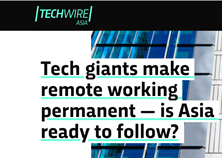What’s the new workplace normal in APAC?
Tech giants making remote working permanent - is Asia ready to follow?
4 minutes to read

Headlines like these abound, but are they asking the question the right way around?
Last week, I looked into changing employee expectations around the workplace. This week, I look at what’s actually been implemented in markets that are no longer seeing the worst of the pandemic. I haven’t covered all the APAC markets, but if you’ve implemented or heard of something unique in your market, I’d love to hear in the comments.
Last Friday, it took a good 45 minutes for me to get a cab from our office at Ocean Financial Centre at 6PM - a problem I haven’t had to face since the beginning of the year. In Singapore, workers are now allowed to come back to the office at least half the time. The CBD looks busier, the MRT is more packed, lunch queues are getting longer, and aside from the mask-wearing and QR code scanning, things feel somewhat back to normal.
The media have highlighted the workplace policies of the Facebooks, Twitters, and Googles of the world. But I haven’t seen as many headlines about tech giants from this side of the world. Asia-Pacific was the first to go into and emerge from lockdown, and if anything at all, the world should be looking at the emerging patterns from this region as an indicator for where the future of work is heading.
Back to normal or new normal?
It’s important to point out that Asia-Pacific isn’t a monolith, and workplace policies and attitudes toward the workplace between countries vary. Certain markets continue to grapple with prolonged or refreshed lockdowns, some have been back to pre-pandemic status quo for some time, while others are introducing more flexible-working policies in the long-term.
In Mainland China, “office buildings and their surrounding amenities are basically operating at pre-COVID-19 levels,” according to Jonathan Rideout who heads Office Services for Knight Frank in Shanghai.
“Despite the appearance of a quick recovery, we are still seeing massive changes in attitudes towards future workplaces. Both struggling companies and thriving companies are moving away from traditional centralised models to localised or dispersed models. For struggling companies, they do not know when their recovery will happen, so flexibility and co-working have gone from ‘nice to have’ to ‘must have’. For thriving companies, for example in technology sectors like gaming or online education, many are young companies with young management who desire dynamic and flexible workplaces,” he continued.
In Hong Kong, with the average apartment being only 470 sq ft, a full lockdown was never enforced, and workplaces have remained open throughout the year. According to Knight Frank’s Intelligence Talks podcast, as of end-August, Hong Kong workers have been spending 22% less time in the office compared to pre-COVID baseline levels (compared to 45% in London and 37% in Paris in August).
With Taiwan’s success in controlling the initial COVID-19 outbreak on its shores, the sense of normalcy is a matter of local pride. Working from home never really took hold, with companies focused more on safeguarding daily operations through temperature checks, according to Taipei Times.
Japanese companies initially resisted remote working, but attitudes are shifting. In July, a survey by Tokyo Shoko Research found that 42% of companies were not implementing remote working despite government calls to do so. However, since then, large companies like Mizuho and Fujitsu have announced more permanent revisions toward flexible working such as giving the option for shorter work weeks or incentives to promote teleworking from rural areas. National parks across Japan have even set up WIFI and workstations in campsites and hotels to welcome teleworkers.
In Australia, we can see that cities with fewer COVID-19 cases have higher office occupancy rates according to a survey by Property Council of Australia. However, despite states like Perth seeing zero community cases for 5 months, the inertia to work away from the CBD has been strong.

So whose example should you follow?
There really is no one-size-fits-all solution (though I really like the idea of working from a national park), as we can see that there are variations from country to country, or even within each country. We’ll likely see more changes in the horizon and different strategies being tested out in Asia-Pacific. Ultimately, workplace strategy is about people, and what works best for employee communication, collaboration, morale, and productivity to drive the business forward.
In my next post, I’d like to delve more closely into the people aspect. What kind of interactions are we missing when we’re not in the office? How would we increase the “collision co-efficient” in a work-from-anywhere world?